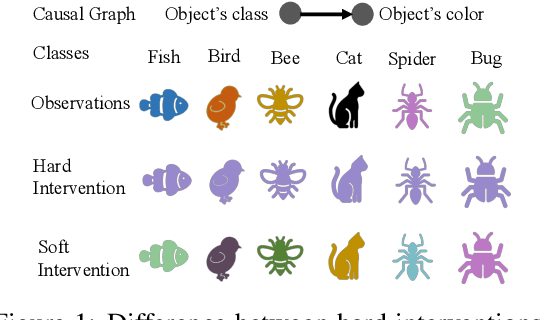Shayan Shirahmad Gale Bagi
Disentanglement in Implicit Causal Models via Switch Variable
Feb 16, 2024



Abstract:Learning causal representations from observational and interventional data in the absence of known ground-truth graph structures necessitates implicit latent causal representation learning. Implicitly learning causal mechanisms typically involves two categories of interventional data: hard and soft interventions. In real-world scenarios, soft interventions are often more realistic than hard interventions, as the latter require fully controlled environments. Unlike hard interventions, which directly force changes in a causal variable, soft interventions exert influence indirectly by affecting the causal mechanism. In this paper, we tackle implicit latent causal representation learning in a Variational Autoencoder (VAE) framework through soft interventions. Our approach models soft interventions effects by employing a causal mechanism switch variable designed to toggle between different causal mechanisms. In our experiments, we consistently observe improved learning of identifiable, causal representations, compared to baseline approaches.
Generative Causal Representation Learning for Out-of-Distribution Motion Forecasting
Feb 17, 2023Abstract:Conventional supervised learning methods typically assume i.i.d samples and are found to be sensitive to out-of-distribution (OOD) data. We propose Generative Causal Representation Learning (GCRL) which leverages causality to facilitate knowledge transfer under distribution shifts. While we evaluate the effectiveness of our proposed method in human trajectory prediction models, GCRL can be applied to other domains as well. First, we propose a novel causal model that explains the generative factors in motion forecasting datasets using features that are common across all environments and with features that are specific to each environment. Selection variables are used to determine which parts of the model can be directly transferred to a new environment without fine-tuning. Second, we propose an end-to-end variational learning paradigm to learn the causal mechanisms that generate observations from features. GCRL is supported by strong theoretical results that imply identifiability of the causal model under certain assumptions. Experimental results on synthetic and real-world motion forecasting datasets show the robustness and effectiveness of our proposed method for knowledge transfer under zero-shot and low-shot settings by substantially outperforming the prior motion forecasting models on out-of-distribution prediction.
Deep Representation of Imbalanced Spatio-temporal Traffic Flow Data for Traffic Accident Detection
Aug 21, 2021



Abstract:Automatic detection of traffic accidents has a crucial effect on improving transportation, public safety, and path planning. Many lives can be saved by the consequent decrease in the time between when the accidents occur and when rescue teams are dispatched, and much travelling time can be saved by notifying drivers to select alternative routes. This problem is challenging mainly because of the rareness of accidents and spatial heterogeneity of the environment. This paper studies deep representation of loop detector data using Long-Short Term Memory (LSTM) network for automatic detection of freeway accidents. The LSTM-based framework increases class separability in the encoded feature space while reducing the dimension of data. Our experiments on real accident and loop detector data collected from the Twin Cities Metro freeways of Minnesota demonstrate that deep representation of traffic flow data using LSTM network has the potential to detect freeway accidents in less than 18 minutes with a true positive rate of 0.71 and a false positive rate of 0.25 which outperforms other competing methods in the same arrangement.
 Add to Chrome
Add to Chrome Add to Firefox
Add to Firefox Add to Edge
Add to Edge